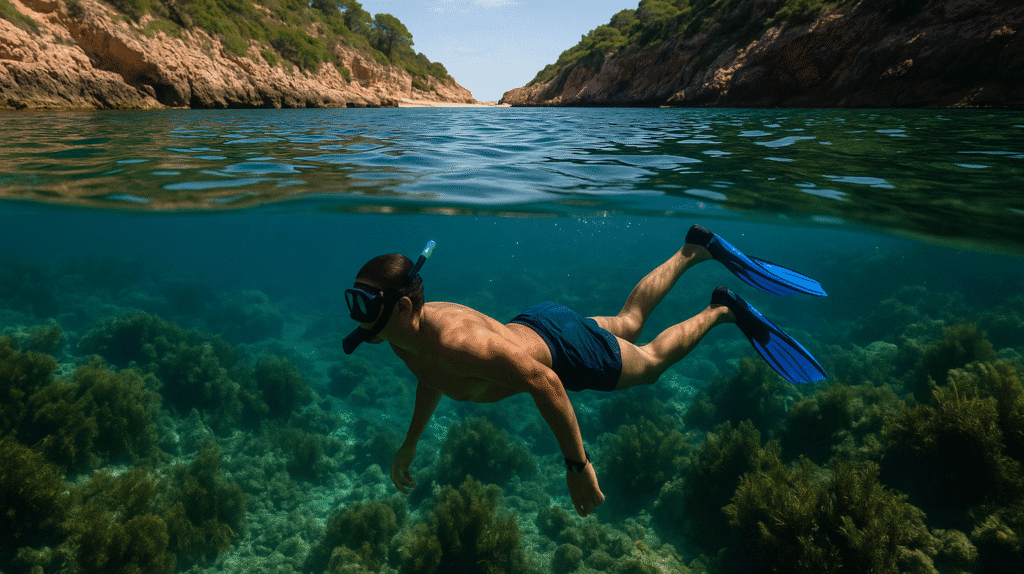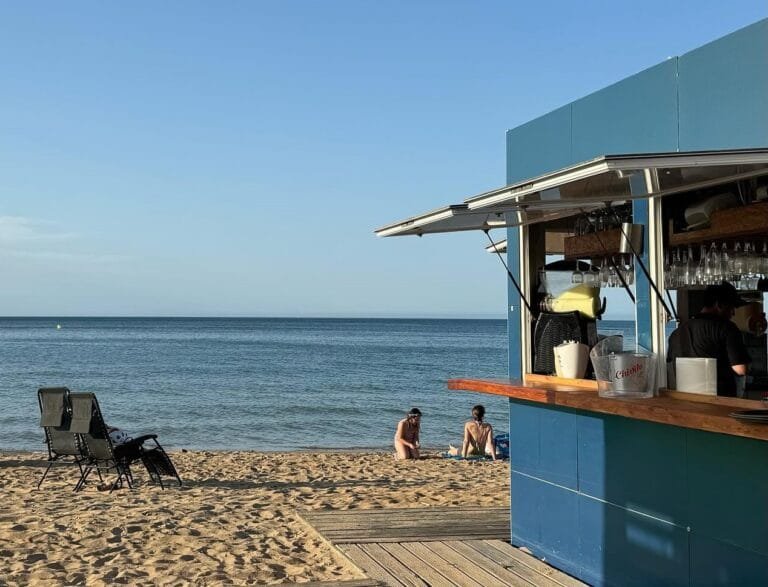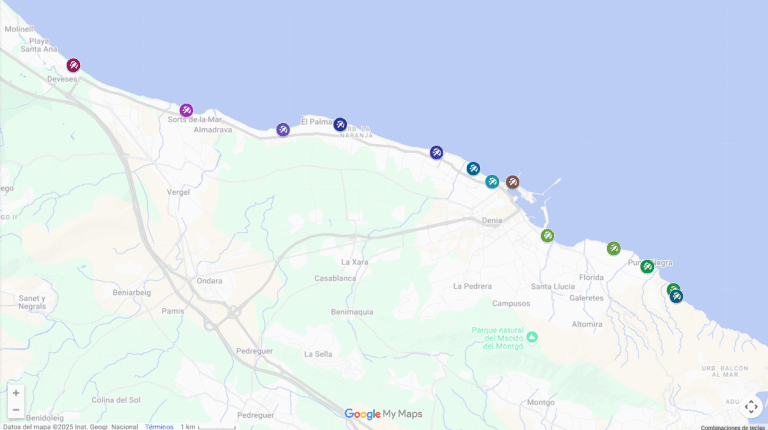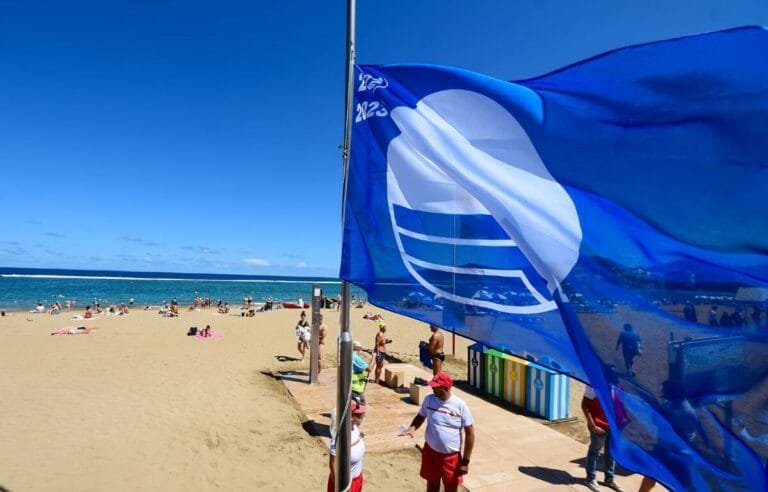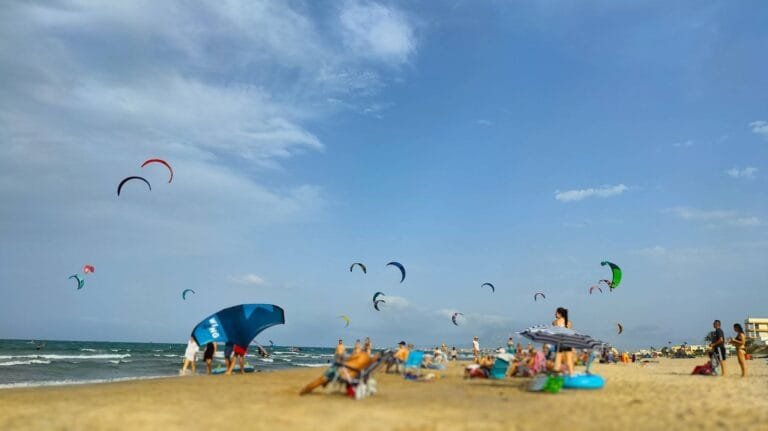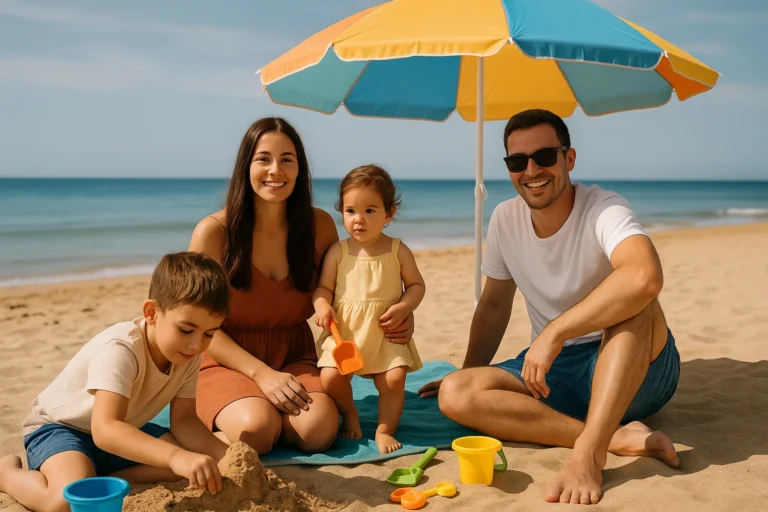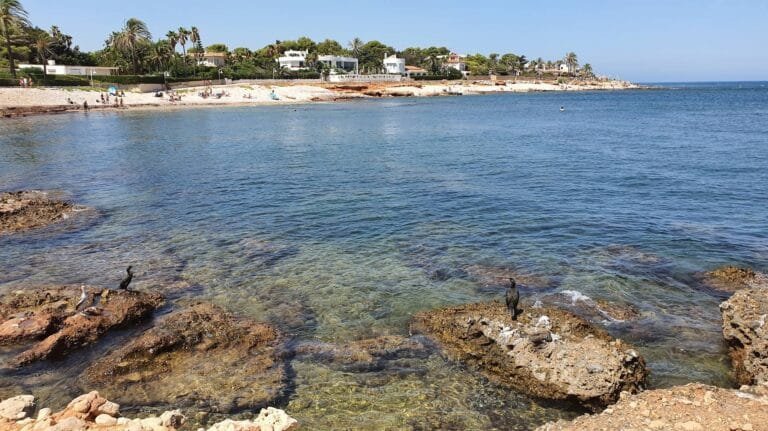When people ask me where to go snorkelling or diving in Spain, I don’t hesitate: Denia. This corner of the Costa Blanca has something special. I’ve spent entire summers exploring every cove, every submerged rock, every nook of the coastline, and what I’ve found beneath its waters is a spectacle I want to share with you.
Whether it’s your first time with a mask and snorkel or you’ve been diving with a regulator around your neck for years, Denia offers an underwater world that combines rich marine life, crystal-clear waters, and unique landscapes, thanks to the Cabo de San Antonio Marine Reserve and the biodiversity that thrives there.
- Why Denia is Ideal for Snorkelling or Diving
- Les Rotas: the Most Spectacular Area for Snorkelling in Denia
- Las Marinas: snorkelling among posidonia and tranquility
- What You Can See Underwater: Typical Marine Life in Denia
- Snorkelling or Diving? Required Permits and Tips
- Practical Tips for Snorkelling in Denia
- Want to Keep Exploring Denia?
Why Denia is Ideal for Snorkelling or Diving
Beneath the surface, there is a universe of life moving among cliffs, posidonia meadows, underwater caves, and freshwater springs. Along its more than 20 km of coastline, you can dive among schools of fish that surround you and discover habitats as varied as rocky coves in the south or wide sandy beaches with underwater meadows in the north.
One of the most impressive experiences I’ve had here was seeing sea turtles come every year to nest in Denia’s sand. In 2024, six nests were discovered. And if luck is on your side, from the Rotas viewpoint you might even spot whales, specifically rorquals, the second-largest animal in the ocean, passing Cabo de San Antonio on their migration to the Atlantic.
All of this makes every dive different, and that’s what has kept me hooked for years.
Map
Les Rotas: the Most Spectacular Area for Snorkelling in Denia
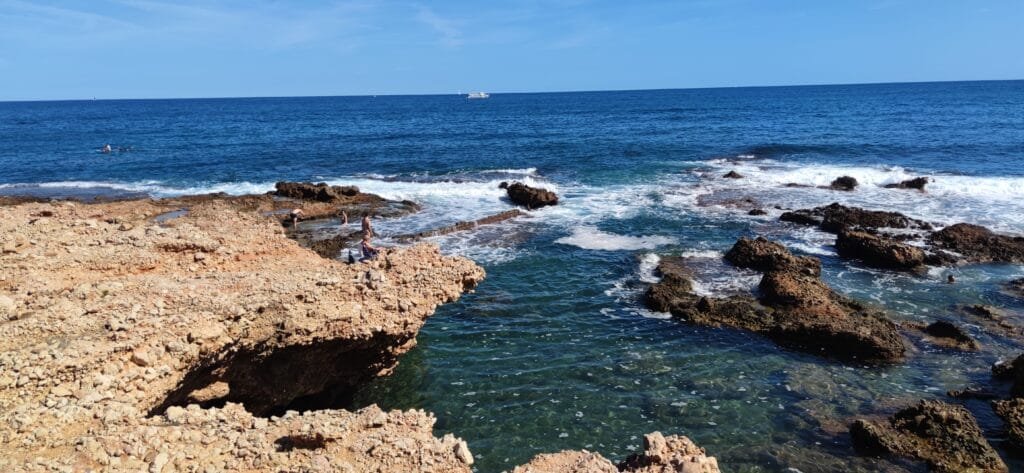
If I had to choose just one area, it would undoubtedly be Les Rotes. I’ve been diving here all my life. This southern part of Denia is protected by the Cabo de San Antonio Marine Reserve, and you notice it as soon as you put your head underwater: colourful fish swimming without fear, sea urchins among the rocks, octopuses peeking out from their hiding spots, and occasionally, the surprise of a starfish.
The entire coastline of Les Rotes is worth exploring, but there are three spots that I consider essential. I’ll share them with you like a little secret.
Cala Punta Negra: perfect for your first dives
Punta Negra is the cove I always recommend to beginners in snorkelling. Here, the initial depth is shallow, making entry and exit easy – ideal for beginners or families with children. But don’t be fooled: although it’s easy to access, marine life is abundant.
I’ve swum among schools of small fish swirling near the shore, and if you venture a little further, the seabed slopes gradually and you can spot larger species. You might also see seabirds like cormorants fishing right in front of you. Additionally, in 2025 this cove was awarded the Blue Flag, guaranteeing cleanliness and services without compromising its natural character. This is where I usually take friends visiting for the first time, and everyone ends up fascinated.
Cala Arenetes: biodiversity and depth in the marine reserve
When I’m looking for something more technical and less crowded, I head to the end of Les Rotes, to Cala Arenetes. This area is very close to the cliffs of Cabo de San Antonio, which already tells you a lot: the waters here are deeper, cooler, and teeming with marine life.
Access has its trick. If you arrive early and secure a spot on the cove, you’ll have to enter the water walking over a rocky platform that’s barely covered (about 10 to 15 cm). Be careful as it’s slippery; wear water shoes or tread carefully. Once you dive in, it all makes sense: visibility is excellent, and biodiversity multiplies.
I’ve seen rockfish, juvenile groupers, schools of saddled bream, gilthead bream, and large white seabream. I’ve also explored small caves and even encountered camouflaged octopuses among the rocks. It’s a spot where even scuba divers go, so you can imagine its potential.
It’s one of those places where you can get lost among the nooks of the rocks, discovering what hides in every corner. Highly recommended for intermediate and advanced snorkellers.
Cala del Aigua Dolç: snorkelling among cliffs
Right next to Arenetes is one of Denia’s most unique coves: Cala del Aigua Dolç. Its name is no coincidence. Here, literally, freshwater springs from the seabed, something I’ve only seen on rare occasions. This phenomenon creates a halocline, a sort of underwater mist when salt and fresh water mix. If you don’t see it, you’ll notice it because the water feels colder.
To reach it, you need to descend a staircase carved into the cliff, and once down, the atmosphere is wild, secluded, and yes, also nudist. It’s a small cove, but very special. The waters are colder and deeper, and to the right are the cliffs, where marine life is abundant and diverse.
I’ve swum here among schools of larger fish, anemones, sea urchins…. The most exciting part is that if the sea is calm and your fitness allows it, you can keep swimming until you reach the Cova Tallada, an open-sea cave that looks straight out of an adventure movie.
Cala del Aigua Dolç is not just a place for snorkelling, it’s an experience in itself. Every time I go, I discover something new.
Las Marinas: snorkelling among posidonia and tranquility
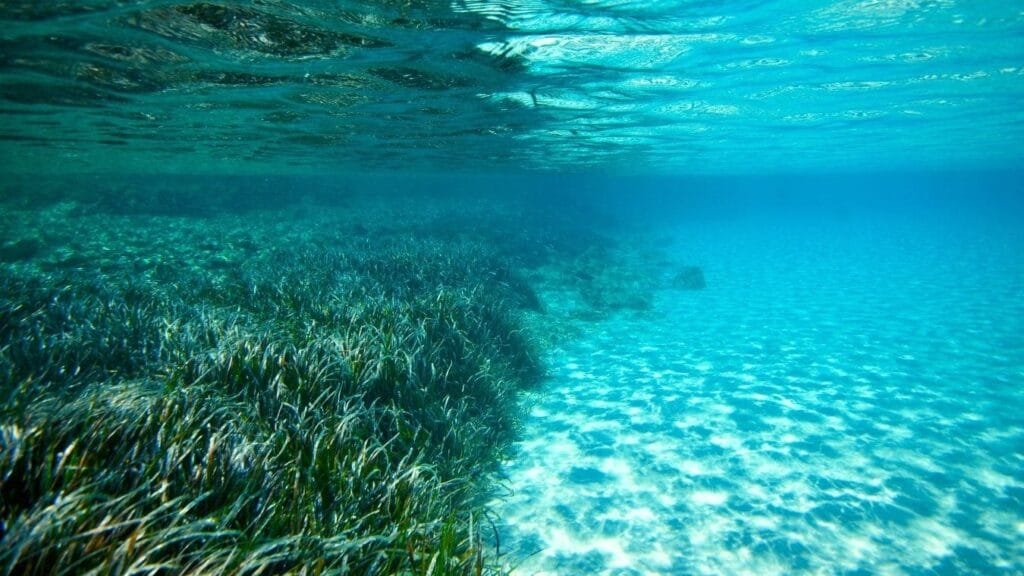
To the north of Denia is the area of Las Marinas, a total contrast with Les Rotes. Here there are no rocks or cliffs, only endless sandy beaches, some urban, others almost untouched. Beneath these waters lie large posidonia meadows, a vital underwater ecosystem for the Mediterranean.
Swimming here feels like gliding through an underwater meadow. The posidonia hosts fish, cuttlefish, small crustaceans, and improves water quality, which is usually clearer. The advantage of Las Marinas is that you can snorkel without walking over stones or dodging rocks. Just grab your mask, step into the water, and you’re ready.
Notable Beaches of Las Marinas: Les Bovetes and La Almadraba
If you want a place with full facilities and easy access to the sea, I recommend Les Bovetes. Just a few metres from the shore, you’ll see posidonia meadows and fish sheltering among the leaves. It’s ideal for families or anyone looking for a peaceful yet lively experience.
On the other hand, if you prefer a more authentic and less crowded environment, the beach of La Almadraba will delight you. It has pebbly shores, which usually keep casual bathers away. But for snorkellers like us, it’s a gem: crystal-clear water, a rocky seabed, and a silence you won’t find on busier beaches.
What You Can See Underwater: Typical Marine Life in Denia
One of the things that hooked me most about snorkelling in Denia was the variety of marine life. I’ve seen it all:
- Schools of salpas, saddled bream, damselfish.
- Octopuses hiding among rocks, watching you with curiosity.
- Sea urchins, starfish, crabs scuttling among the crevices.
- Colourful rockfish protecting their little corners.
- Giant jellyfish, fascinating to observe carefully, some are harmless.
Each area has its own character. In Les Rotes, the rocky seabed attracts rock-dwelling species. In Las Marinas, the posidonia meadows serve as nurseries and shelters.
Snorkelling or Diving? Required Permits and Tips
Snorkelling in Denia is free and doesn’t require any authorisation. But if your thing is scuba diving and you want to explore the Cabo de San Antonio Marine Reserve, you’ll need to apply for a specific permit.
Required Documentation:
- Photocopy of ID
- Accident insurance
- Diver certification
- Official form (according to Decree 19/2015, DOCV Nº 7466/16.02.2015) downloadable here
Where to Apply:
- Territorial Office of Agriculture, Fisheries, Food and Water of Alicante (Tel: 965900600)
- Denia Town Hall (entry registry)
- PROP Offices
My advice: apply for the permit in advance, especially during high season. It’s worth it. The seabeds in this area are spectacular.
Practical Tips for Snorkelling in Denia
Here are my golden tips after years of practice:
- Best season: from May to October. The water is warm and clear.
- Basic equipment: mask, snorkel, fins, and biodegradable sunscreen.
- Avoid the hottest hours, especially under direct sunlight.
- Check the wave forecast before heading out, particularly if you’re going to deeper coves.
- Wear water shoes if visiting rocky areas like Les Rotes.
- Respect the wildlife and don’t touch anything. Observe yes, disturb no.
Want to Keep Exploring Denia?
If you’ve enjoyed this guide on snorkelling and diving in Denia, you’ll love continuing to explore all that our coastline has to offer.
I invite you to read these two must-read articles:
- 👉 The Best Beaches in Denia: a complete tour of the most spectacular beaches, from hidden coves to wide sandy stretches perfect for a full day by the sea.
- 👉 The Best Beaches in Denia for Families with Children: if you’re travelling with family, here you’ll find safe, accessible beaches with all the facilities for a worry-free day out.
Keep exploring playasdenia.es and discover why this Mediterranean gem has something special for every type of traveller. See you under the water… or at the next cove.

